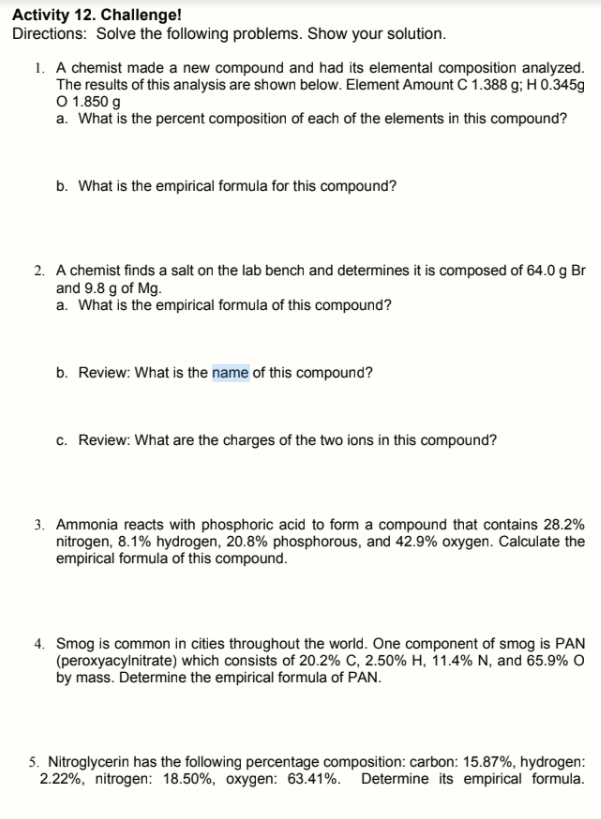1. A chemist made a new compound and had its elemental composition analyzed. The results of this analysis are shown below. Element Amount C 1.388 g; H 0.345g O 1.850 g a. What is the percent composition of each of the elements in this compound? b. What is the empirical formula for this compound?
1. A chemist made a new compound and had its elemental composition analyzed. The results of this analysis are shown below. Element Amount C 1.388 g; H 0.345g O 1.850 g a. What is the percent composition of each of the elements in this compound? b. What is the empirical formula for this compound?
Chemical Principles in the Laboratory
11th Edition
ISBN:9781305264434
Author:Emil Slowinski, Wayne C. Wolsey, Robert Rossi
Publisher:Emil Slowinski, Wayne C. Wolsey, Robert Rossi
Chapter29: Synthesis And Analysis Of A Coordination Compound
Section: Chapter Questions
Problem 1ASA
Related questions
Question

Transcribed Image Text:Activity 12. Challenge!
Directions: Solve the following problems. Show your solution.
1. A chemist made a new compound and had its elemental composition analyzed.
The results of this analysis are shown below. Element Amount C 1.388 g; H 0.345g
O 1.850 g
a. What is the percent composition of each of the elements in this compound?
b. What is the empirical formula for this compound?
2. A chemist finds a salt on the lab bench and determines it is composed of 64.0 g Br
and 9.8 g of Mg.
a. What is the empirical formula of this compound?
b. Review: What is the name of this compound?
c. Review: What are the charges of the two ions in this compound?
3. Ammonia reacts with phosphoric acid to form a compound that contains 28.2%
nitrogen, 8.1% hydrogen, 20.8% phosphorous, and 42.9% oxygen. Calculate the
empirical formula of this compound.
4. Smog is common in cities throughout the world. One component of smog is PAN
(peroxyacylnitrate) which consists of 20.2% C, 2.50% H, 11.4% N, and 65.9% O
by mass. Determine the empirical formula of PAN.
5. Nitroglycerin has the following percentage composition: carbon: 15.87%, hydrogen:
2.22%, nitrogen: 18.50%, oxygen: 63.41%. Determine its empirical formula.
Expert Solution
This question has been solved!
Explore an expertly crafted, step-by-step solution for a thorough understanding of key concepts.
This is a popular solution!
Trending now
This is a popular solution!
Step by step
Solved in 2 steps with 1 images

Recommended textbooks for you

Chemical Principles in the Laboratory
Chemistry
ISBN:
9781305264434
Author:
Emil Slowinski, Wayne C. Wolsey, Robert Rossi
Publisher:
Brooks Cole

Principles of Modern Chemistry
Chemistry
ISBN:
9781305079113
Author:
David W. Oxtoby, H. Pat Gillis, Laurie J. Butler
Publisher:
Cengage Learning


Chemical Principles in the Laboratory
Chemistry
ISBN:
9781305264434
Author:
Emil Slowinski, Wayne C. Wolsey, Robert Rossi
Publisher:
Brooks Cole

Principles of Modern Chemistry
Chemistry
ISBN:
9781305079113
Author:
David W. Oxtoby, H. Pat Gillis, Laurie J. Butler
Publisher:
Cengage Learning


Chemistry: Matter and Change
Chemistry
ISBN:
9780078746376
Author:
Dinah Zike, Laurel Dingrando, Nicholas Hainen, Cheryl Wistrom
Publisher:
Glencoe/McGraw-Hill School Pub Co

Introductory Chemistry: A Foundation
Chemistry
ISBN:
9781285199030
Author:
Steven S. Zumdahl, Donald J. DeCoste
Publisher:
Cengage Learning

Chemistry & Chemical Reactivity
Chemistry
ISBN:
9781337399074
Author:
John C. Kotz, Paul M. Treichel, John Townsend, David Treichel
Publisher:
Cengage Learning